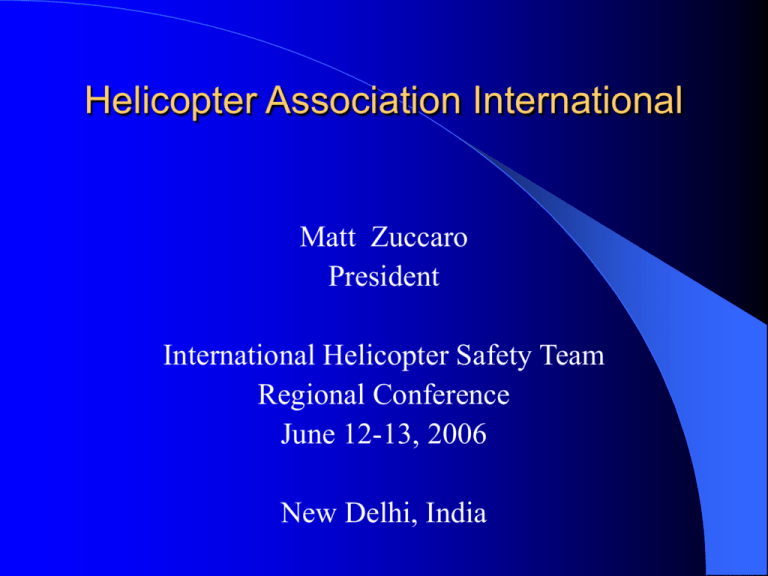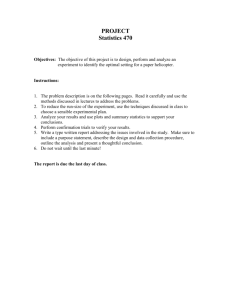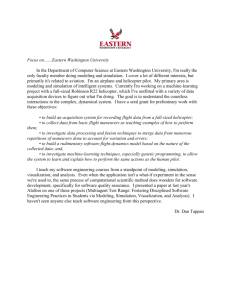Address
advertisement

Helicopter Association International Matt Zuccaro President International Helicopter Safety Team Regional Conference June 12-13, 2006 New Delhi, India Thank You DGCA COSCAP ROTORY WING ASSOCIATION OF INDIA For your Sponsorship of the IHST Regional Conference And Hospitality extended to IHST members Helicopter Association International – Established 1948 – The professional trade association for the civil helicopter industry – 2,600 + members in 73 countries – Members include: helicopter owners, operators, manufacturers & suppliers, service organizations, affiliate associations, pilots & mechanics, people interested in the rotorcraft industry Helicopter Association International – HAI Members operate nearly 4,500 helicopters and fly nearly 2.3 million hours each year – HAI is dedicated to the promotion of the helicopter as a safe, effective method of commerce and to the advancement of the civil helicopter industry Helicopter Operations Commercial & Private Corporate Air Taxi Construction ENG HEMS Law Enforcement Logging Air Tours Agricultural Applications Instruction / Training Utilities Patrol / Construction Firefighting Mineral Exploration Helicopter Operations Government & Military - Law Enforcement – Drug Interdiction – Firefighting – Customs – Search and Rescue – HEMS – Homeland Security – Department of Defense (Military) Helicopter Association International Gulf of Mexico ADSB PROGRAM Automatic Dependent Surveillance Broadcast ADSB in the Gulf of Mexico To appreciate the benefits Of ADSB in the GOM You must understand the current operating environment GOM OPERATING OVERVIEW • Helicopter Fleet 650 aircraft • Offshore Platforms 5,000 + • Average trips 7,500 per day • Ops per year 2.1 million • Passengers per year 2.6 million • Flight hours per year 380,000 Inclusive Airspace Operating area extends over 500 nm along the Texas, Louisiana, Mississippi Coastline Encompasses the area from 20 miles onshore extending 250 miles out over the water of the Gulf of Mexico Type of Operations VFR & IFR Single engine / Multiengine Single pilot / two pilot Passenger / cargo Medical evacuation Most operations are conducted between the surface and 5,000 feet SIGNIFICANT FACT Currently the majority of helicopters operating Offshore in the Gulf of Mexico do so without the ability to communicate with, or be seen by Air traffic Control They also do so without the normal infrastructure To provide current weather information, or other generally expected services as provided to similar operations when conducted over land Weather considerations IFR DAYS: – Operator capacity reduced by 95 % Due to lack of: – Adequate communications – Surveillance capability – Real-time weather information Negative economic impact on offshore oil / gas Activity can cost several million dollars per day ADSB – GOM BENEFITS Enhance overall safety Provide low level communications Allow ATC surveillance of aircraft Provide current / forecast weather info Provide surveillance between aircraft Increase operational capacity Enhance economics of operation FAA / INDUSTRY - MOA BASICS • FAA – ADSB GOM System • Fund • Install • Operate • INDUSTRY – ADSB GOM SYSTEM • • • Transport to platforms Space on platforms for equipment Equip aircraft PARTICIPANTS FAA HELICOPTER ASSOCIATION INTERNATIONAL GOM HELICOPTER OPERATORS GOM PLATFORM OPERATORS GOM PLATFORM OWNERS CURRENT STATUS M.O.A. SIGNED 5/18/06 FAA FUNDING WAS APPROVED JUNE 7, 2006 ADSB BENEFITS TO HELICOPTERS Due to the very nature of the helicopter operating environment Our segment of the industry stands to reap the greatest rewards from ADSB Technology “ADSB EFFECT ON THE HELICOPTER INDUSTRY The implementation of ADSB in the Gulf of Mexico will eventually change the way the international helicopter community operates FIRST RESPONDER PROGRAM FIRST RESPONDER PROGRAM HAI is developing a web based database that will quickly identify and locate available assets worldwide, so they can be used effectively in response to natural disasters such as hurricanes, tsunami, earthquakes and terrorist attacks FIRST RESPONDER PROGRAM What are “assets?” Helicopters (with specific capabilities) Pilots Mechanics Coordinators Support personnel VOLUNTARY REGISTRATION • Operators & individuals Easily enter and change information Can easily opt in or out of program COLLECTION OF INFORMATION • PROVIDED BY OPERATORS Available aircraft Capabilities Updated information Location Contact(s) • Must be current Updated directly by operator near real-time Indicates intention but not guarantee FIRST RESPONDER PROGRAM Who uses the Program? Those individuals, agencies or governments who are responsible for the management of the response efforts to natural disasters and terrorist events SEARCH CAPABILITIES • Searchable Aircraft location Aircraft capabilities Availability determined by contact • Will be secure Highly restricted access (Search) Up & running 24/7 Input by Trusted agents FIRST RESPONDER DATABASE • Program Development • HAI Sourced & controlled Moved from concept to design Has been field tested Will remain a work in progress Will be activated on July 1, 2006 Need input from operators, government HELI - EXPO HELI-EXPO is the world’s largest exposition dedicated to the international helicopter industry Heli-Expo 2006 Broke all records 16,628 attendees 526 Exhibitors 1,871 Booths 51 Display aircraft 600 + students – HAI educational courses JOIN US AT HELI-EXPO 2007 ORLANDO MARCH , FLORIDA 1-3, 2007 “SAFETY IS THE TOPIC” It holds the key to our future It effects everything we do It must remain our top priority, above all else International Helicopter Safety Team INTERNATIONAL HELICOPTER SAFETY TEAM COLLABRATIVE EFFORT BETWEEN HAI / AHS / INDUSTRY TO IMPROVE INTERNATIONAL HELICOPTER SAFETY OVERALL GOAL REDUCE THE INTERNATIONAL HELICOPTER ACCIDENT RATE BY 80 % OVER THE NEXT 10 YEARS International Helicopter Safety Team Representative 2004 Accident Rates per 100,000 Flight Hours: U.S. General Accident Rate U.S. Civil Helicopter Accident Rate U.S. Civil Turbine Helicopter Accident Rate U.S. On Demand Air Taxi Accident Rate U.S. Air Carrier (CFR 121) Accident Rate 6.22 8.09 5.11 2.21 0.159 Source: Aviation Underwriters Association International Helicopter Safety Team Definition of Civil Accident (ICAO Annex 13 and NTSB – 14 C.F.R. 830.2): “Aircraft accident” means an occurrence associated with the operation of an aircraft which takes place between the time any person boards the aircraft with the intention of flight and all such persons have disembarked, and in which any person suffers death or serious injury, or in which the aircraft receives substantial damage. International Helicopter Safety Symposium IHSS 2005 MONTREAL Outcome: Acknowledgement that the helicopter accident rate is too high and must be reduced. Adoption of the goal to reduce the helicopter accident rate by 80% within 10 years Pursuit of the goal using a process modeled after the successful scheduled air carrier initiative known as the “Civil Aviation Safety Team” or CAST. Executive Committee Secretariat IHST JHSAT JHSIT Subcommittees Subcommittees IHST A Three-Stage Process Data Analysis Implement Safety Enhancements U.S. Set Safety Priorities Agree on problems and interventions Achieve consensus on priorities Influence Safety Enhancements Worldwide Integrate into existing work and distribute International Helicopter Safety Team IHST Executive Committee consists of: Industry/Operator Co-Chair Government Co-Chair Secretariat Member Member Member Matt Zuccaro, HAI Dave Downey, FAA Rhett Flater, AHS Bob Sheffield, Shell Aircraft Somen Chowdhury, Bell Don Sherritt, Transport Canada International Helicopter Safety Team IHST will be broadly inclusive, and include: Operator associations (HAI /AHS affiliates) and select operators (including military) Airframe & engine OEMs, turbine & piston The regulatory community (FAA, Transport Canada, ICAO, EASA, etc) Insurance industry Client base. How YOU can help…… http://www.ihst.org IHST STATUS IHST / JHSAT / FORMED – FUNCTIONING JHSIT NOW BEING FORMED PRESENTATIONS – WORLDWIDE SECURE INTERNATIONAL PARTICIPATION LOOKING FOR MEMBERS The Environment Twin vs. Single engine VFR vs. IFR Urban vs. rural vs. offshore vs. Int’l Missions – R22 training – S-92 Corporate 1 aircraft to 300 aircraft fleets Commercial vs. private / corporate FIRST QUESTION DO WE HAVE A SAFETY PROBLEM ? SECOND QUESTION DO THIRD PARTIES THINK HELICOPTERS ARE SAFE ? – The general public – Elected officials – Potential clients – Regulatory agencies E.M.S. Operations Helicopters save lives Thousands of lives are saved each year HEMS HEMS accidents continue to occur 67 fatalities and 32 serious injuries since 2000 U.S. Turbine Helicopter CFIT Accidents 1992 - 2004 12 Part 135 Part 91 Number of Accidents 10 8 6 4 2 0 1992 1993 1994 1995 1996 1997 Based on accidents in U.S. between 1992 - 2004 (NTSB Database) 1998 1999 2000 2001 2002 Year 2003 2004 U.S. Turbine Helicopter CFIT Accidents Phase of Flight Time of Day Takeoff 7% Dawn 3% Approach 16% Night 42% Maneuver 10% Day 52% Dusk 3% Instrument vs. Visual Cruise 67% Threat Types Obstacle 4% IMC 39% Water 28% VMC 61% Terrain 68% Based on accidents in U.S. between 1992 - 2004 (NTSB Accident Database) Where does the public get a perception of our industry ? Press coverage of industry events Depictions in entertainment media (v) We need to ask ourselves Are we really unsafe ? Are our employees and clients at high risk ? Should the public trust us ? How do we improve our image ? How much safety can you afford ? Basic premise for consideration IF YOU THINK SAFETY IS EXPENSIVE TRY AN ACCIDENT What are the negative effects of an accident ? Loss of Life – Injuries Loss of the aircraft / a revenue producer Detrimental to existing & new heliports/facilities Potential of restricted airspace Reduction in existing clients & business Elimination of new client & business potential Insurance availability and rates Litigation Regulatory scrutiny Is technology the answer Do we need more boxes? TAWS EGPWS HUMS ADSB GPS / WAAS Maybe Not Recent fatal accidents involved – – – – – – Twin engine IFR aircraft Autopilot equipped Two pilot IFR qualified crew VFR operations Advanced cockpit Familiar operating environment Are you still with me ? Some thoughts Non punitive safety reporting environment • Safety Management Systems / Safety Cases Risk Assessment program (Mngmt Oversight) Reward risk aversion / not risk taking Most difficult task SALES & MARKETING OF SAFETY THE BUY IN Safety Culture Manufacturers Regulatory agencies Elected Leaders Communities / Public Operators / Owners Management Pilots / Techs Clients EVERYONE HAS TO BE INVOLVED HELICOPTERS ARE DIFFERENT 24 / 7 CAPABILITY SITE OPERATIONS – UNKNOWN ISSUES REMOTE LOCATIONS NO SUPPORTING INFRASTRUCTURE MISSION COMPLETION PRESSURES MEDICAL INPUT TO OPS DECISIONS MARKET COMPETITION ECONOMIC MOTIVATORS / DETERMINANT ULTIMATE RECOMMENDATIONS • MUST BE ECONOMICALLY VIABLE • OPERATIONALLY APPROPRIATE TO THE SPECIFIC OPERATING ENVIRONMENT AND MISSION • MUST CONSIDER RETROFIT CAPABILITY TO EXISTING FLEET SOME CONSIDERATIONS RECENT USA ACCIDENT OFFSHORE AIR TOUR EMS (CFIT) (2 EVENTS) (FINAL ATTEMPT) CLIENT LACK OF KNOWLEDGE “OTHER GUY WILL DO IT – CERTIFICATED” “THAT IS WHAT INSURANCE IS FOR” HELICOPTER INDUSTRY EXPERIENCE LEVELS Expansion of overall business activity Retirement of VietNam Era personnel Higher client standards Lack of young people entering industry POTENTIAL EFFECT ON SAFETY Currently experiencing initial effect of a shortage of experienced pilots and technicians Inability of operators to meet business demands and client standards is real. Lower experience levels could result in higher accident rates if proper initiatives and cultures are not put in place. ACCURATE DATA ACCURATE HELICOPTER FLIGHT HOURS FLOWN ARE ESSENTIAL ACCIDENT RATE MIGHT BE LOWER THAN WE CURRENTLY BELIEVE MY CAR ONSTAR SYSTEM INSTANT COMMUNICATIONS GPS TRACKING – REALTIME POSITION AUTOMATIC EMERGENCY NOTIFICATION SYSTEMS DIAGNOSTICS INDSUTRY CULTURE CHANGE IS REQUIRED CHANGE THE CULTURAL MINDSET OF THE APPROPRIATE PARTIES MUST EFFECT DAILY DECISION MAKING MAKE SAFETY PRIMARY OVER ALL ELSE WALK THE WALK NOT JUST TALK THE TALK YOUR PARTICIPATION IS CRITICAL IHST WEBPAGE: WWW.IHST.ORG MATT ZUCCARO HAI OFFICE: E-MAIL: 703-683-4646 TAILROTOR@AOL.COM HAI WEBPAGE: WWW.ROTOR.COM Questions?






